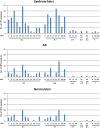Eyebrow hairs from actinic keratosis patients harbor the highest number of cutaneous human papillomaviruses
- PMID: 23618013
- PMCID: PMC3642014
- DOI: 10.1186/1471-2334-13-186
Eyebrow hairs from actinic keratosis patients harbor the highest number of cutaneous human papillomaviruses
Abstract
Background: Cutaneous human papillomavirus (HPV) infections seem to be associated with the onset of actinic keratosis (AK). This study compares the presence of cutaneous HPV types in eyebrow hairs to those in tissues of normal skin and skin lesions of 75 immunocompetent AK patients.
Methods: Biopsies from AK lesions, normal skin and plucked eyebrow hairs were collected from each patient. DNA from these specimens was tested for the presence of 28 cutaneous HPV (betaPV and gammaPV) by a PCR based method.
Results: The highest number of HPV prevalence was detected in 84% of the eyebrow hairs (63/75, median 6 types) compared to 47% of AK lesions (35/75, median 3 types) (p< 0.001) and 37% of normal skin (28/75, median 4 types) (p< 0.001), respectively. A total of 228 HPV infections were found in eyebrow hairs compared to only 92 HPV infections in AK and 69 in normal skin. In all three specimens HPV20, HPV23 and/or HPV37 were the most prevalent types. The highest number of multiple types of HPV positive specimens was found in 76% of the eyebrow hairs compared to 60% in AK and 57% in normal skin. The concordance of at least one HPV type in virus positive specimens was 81% (three specimens) and 88-93% of all three combinations with two specimens.
Conclusions: Thus, eyebrow hairs revealed the highest number of cutaneous HPV infections, are easy to collect and are an appropriate screening tool in order to identify a possible association of HPV and AK.
Figures



Similar articles
-
Viral DNA detection and RAS mutations in actinic keratosis and nonmelanoma skin cancers.Br J Dermatol. 2010 Feb 1;162(2):325-31. doi: 10.1111/j.1365-2133.2009.09480.x. Epub 2009 Aug 29. Br J Dermatol. 2010. PMID: 19849697
-
Presence of human papillomavirus DNA in plucked eyebrow hairs is associated with a history of cutaneous squamous cell carcinoma.J Invest Dermatol. 2003 Dec;121(6):1531-5. doi: 10.1046/j.1523-1747.2003.12632.x. J Invest Dermatol. 2003. PMID: 14675206
-
Betapapillomavirus infection profiles in tissue sets from cutaneous squamous cell-carcinoma patients.Int J Cancer. 2010 Jun 1;126(11):2614-21. doi: 10.1002/ijc.24991. Int J Cancer. 2010. PMID: 19856311
-
Prevalence and Concordance of Cutaneous Beta Human Papillomavirus Infection at Mucosal and Cutaneous Sites.J Infect Dis. 2017 Jul 1;216(1):92-96. doi: 10.1093/infdis/jix245. J Infect Dis. 2017. PMID: 28549147 Free PMC article.
-
The role of human papillomavirus in common skin conditions: current viewpoints and therapeutic options.Cutis. 2010 Nov;86(5):suppl 1-11; quiz suppl 12. Cutis. 2010. PMID: 21214125 Review.
Cited by
-
Molecular characterization, tissue tropism, and genetic variability of the novel Mupapillomavirus type HPV204 and phylogenetically related types HPV1 and HPV63.PLoS One. 2017 Apr 20;12(4):e0175892. doi: 10.1371/journal.pone.0175892. eCollection 2017. PLoS One. 2017. PMID: 28426749 Free PMC article.
-
[Low-dose prophylactic oral isotretinoin treatment for 18 years in a patient with epidermodysplasia verruciformis and numerous squamous cell carcinomas].Hautarzt. 2018 Dec;69(12):1033-1038. doi: 10.1007/s00105-018-4267-6. Hautarzt. 2018. PMID: 30250966 German.
-
Commensal papillomavirus immunity preserves the homeostasis of highly mutated normal skin.Cancer Cell. 2025 Jan 13;43(1):36-48.e10. doi: 10.1016/j.ccell.2024.11.013. Epub 2024 Dec 12. Cancer Cell. 2025. PMID: 39672169
-
Natural history of cutaneous human papillomavirus (HPV) infection in men: the HIM study.PLoS One. 2014 Sep 8;9(9):e104843. doi: 10.1371/journal.pone.0104843. eCollection 2014. PLoS One. 2014. PMID: 25198694 Free PMC article. Clinical Trial.
-
HPV8-induced STAT3 activation led keratinocyte stem cell expansion in human actinic keratoses.JCI Insight. 2024 Jun 25;9(15):e177898. doi: 10.1172/jci.insight.177898. JCI Insight. 2024. PMID: 38916963 Free PMC article.
References
-
- International Agency for Research on Cancer. IARC monographs on the evaluation of carcinogenic risks to humans. Human papillomaviruses. IARC Lyon France. 1995;64
-
- Proby CM, Harwood CA, Neale RE, Green AC, Euvrard S, Naldi L, Tessari G, Feltkamp MC, de Koning MN, Quint WG, Waterboer T, Pawlita M, Weissenborn S, Wieland U, Pfister H, Stockfleth E, Nindl I, Abeni D, Schegget JT, Bouwes Bavinck JN. A case–control study of betapapillomavirus infection and cutaneous squamous cell carcinoma in organ transplant recipients. Am J Transplant. 2011;11:1498–1508. doi: 10.1111/j.1600-6143.2011.03589.x. - DOI - PubMed
Publication types
MeSH terms
Substances
LinkOut - more resources
Full Text Sources
Other Literature Sources

